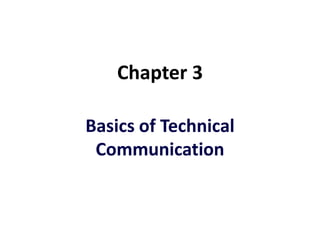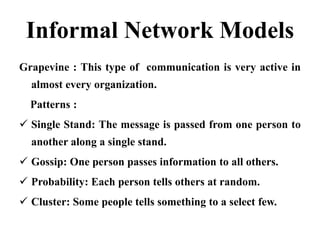Chapter 3
- 1. Chapter 3 Basics of Technical Communication
- 2. Objectives of the Lesson âĒ The purpose/objectives and characteristics of Technical Communication. (TC) âĒ The Constituents/components of TC. âĒ Levels of TC âĒ Flow of Communication in an organization âĒ Communication Network modules and their functions/role âĒ Use of audio- visual aids in Communication
- 3. General Vs Technical âĒ General Technical General message Technical Message Informal in style Formal Style No set pattern A set formal pattern Mostly Oral Mostly written No specific audience For a specific audience No technical words Jargons used
- 4. Process of Communication The transmission and interchange of ideas, facts, feelings or courses of action is known as the process of communication. All the activities an organization undertake have communication at their centre. An employee should have good communication skills along with the subject knowledge
- 5. Objectives of the TC âĒ To provide organized information that aids in quick decision- making. âĒ To make the working smooth. âĒ To invite corporate joint ventures. âĒ To share knowledge in oral & written forms.
- 6. Characteristics of TC âĒ Technical communication has to be correct, accurate, clear, appropriate and to the point. âĒ Correct information is objective information.
- 7. Communication Environment (CE) Communication Environment includes: 1.Sender 2.Receiver 3)Message 4) Barriers 5) In short a well defined Set -up
- 8. Communication Cycle 1. Formulation: wherein the sender forms the content of the message to be sent. ( the content once formed, is called the message.) 2. Encoding: Sender encodes the message. 3. Transmission: After proper encoding message is delivered through appropriate channel /s
- 9. Communication Cycle contâĶ . Decoding: Receiver decodes the message and act on it. 5. Noise : Breakdown or interference in the message is called Noise. It affects the decoding part of the communication. 6. Feedback: The receiver's response to the sender is called feedback. The communication cycle is complete and effective only when there is a desired responses from the receiver
- 10. Effective communication âĒ Effective communication takes place in a well-defined set-up. This is called communication environment . The essentials of effective communication are: âĒ A well-defined communication environment âĒ Cooperation between sender and the receiver âĒ Selection of an appropriate channel âĒ Correct encoding and decoding of the message âĒ Feedback
- 11. Levels of Communication âĒ Extra-personal: Communication between human beings and non-human entities is extra personal, where only the human side transmits the msg. Human to animals. âĒ Intrapersonal: within an individual analysing, weighing, planning etc.
- 12. Levels of Communication contâĶ âĒ Interpersonal: Between and among humans â face to face so thereâs an immediate feedback. âĒ Organizational: - Internal-operational: Takes place in the process/ functions of organization. - External-operational: Work-related communication with people outside the organization
- 13. Levels of Communication contâĶ âĒ Mass-communication: Meant for large audiences/masses. No particular audience. Transmitted through mass media such as news papers, TV, Radio etc. Ma - Large reach: reach audience scattered over a wide geographical area., without the constraints of time. - Impersonality: Largely impersonal, the sender and receiver are not know to each other a great challenge to be effective âĒ - Gate Keeper â A watch keeper for mass communication.
- 14. Communication Flow âĒ Formal : - hierarchy -Vertical ( up, down) - Horizontal -Diagonal âĒ Informal : Grapevine âĒ - Single strand âĒ - Gossip âĒ - Probability âĒ - Cluster
- 15. Vertical Communication Downward & Upward âĒ Vertical: follows each hierarchical levels of command. Bureaucratic âĒ Downward Communication: From superiors to subordinates - Instructions, new policies, procedures, clarifications, feedback) âĒ Upward Communication: Subordinates to superiors ( submission of information, reports, input.
- 16. Flow of Communication contâĶ âĒ Horizontal Communication: sharing info with the peers bypassing the vertical chain, informal, verbal âĒ Diagonal Communication (DC): flows in all directions and cuts across the various levels in an organization. Ex: A marketing guy directly communicating the marketing need to a reporter not an editor. Increased use of E-mails promotes DC
- 17. Hierarchical V/s other types Formal Informal Mails, Memos, Oral Centraized Decentralized Full proof Gaps likelky Time taking Quick Held up, delayed Immediate Information in one information shared hand
- 18. Communication Networks âĒ A variety of patterns emerge when vertical, horizontal and diagonal channels combine âĒ . These patterns are termed as communication networks. âĒ Formal Network Models: In formal communication five common communication networks exists â chain, Y, wheel, circle and all-channel.
- 19. Communication network contâĶ âĒ Chain Network: A vertical hierarchy in which communication can flow only in upward or downward. âĒ Y Network : A multi-level hierarchy and a combination of horizontal and vertical flow of communication. âĒ Wheel Network: Several subordinates reporting to a superior. This is a combination of horizontal and diagonal flow of communication. âĒ Circle Network: Employees interact with adjacent members but no further.
- 20. Communication Network contâĶ âĒ All Channel Network: Least structured, enables each employee to communicate freely with all the others. For effective use of communication networks, we need to remember the following : ïž No single network is suitable for all occasions. ïž The wheel and all-channel networks are preferred if speed of communication is a priority. ïž The chain, Y, and wheel networks serve best when accuracy is crucial.
- 21. Informal Network Models Grapevine : This type of communication is very active in almost every organization. Patterns : ïž Single Stand: The message is passed from one person to another along a single stand. ïž Gossip: One person passes information to all others. ïž Probability: Each person tells others at random. ïž Cluster: Some people tells something to a select few.
- 22. Grapevine contâĶ âĒ Effective use of grapevine âĒ Not ignore information received through the grapevine. âĒ Use this channel to supplement the formal channel. âĒ Identify but not threaten the main sources of information. âĒ Try to understand the human relationships involved in grapevine. âĒ MBWA â Management by walking around adopted by Walt Disneyâs Chairman Michael Eisner for improving the performance.
- 23. Merits and Demerits of Grapevine communication âĒ Merits Demerits âĒ Quick, interesting, Damaging at times âĒ Resolution without Not authentic âĒ conflict Not reliable âĒ Self â motivating Irresponsible âĒ A gateway to Thrives on opinion âĒ Anxieties, anger not facts âĒ Mirror of reality Colours the facts
- 24. Visual Aids In Technical Communication âĒ Visual aids complement verbal communication. âĒ Concepts: Depicts conceptual things using boxes and circles connected with lines. âĒ Objects: Photographs, drawings, diagrams, and schematics are the types of graphics that show objects. âĒ Numbers: Used for presenting data and statistics in the form of bar charts, pie charts, or line graphs. âĒ Words: Graphics are also used to depict words like when, why and how.
- 25. Types of Visual aids âĒ Tables: Systematic arrangement of numbers, words, or phrases in row an columns, used to depict original numerical data as well as deserved statistics. âĒ Graphs: ïž Axis Labels: in bar graphs and line graphs indicate the categories and values, respectively, represented by the x and y axis. ïž Legend: Bar graphs, and pie graphs often use special colour, shading or line style.
- 26. Types of Visual Aids contâĶ. ïž Graph title: a numbered title. ïž Cross-reference: Brief explanation of what is going on in the graphic, how to interpret it, what its basic trends are and so on. ïž Documentation: Source of any information that is borrowed in order to create a graphic must be cited along with the graphic. The standard format should be used to indicate the source.
- 27. ïž Graph title: a numbered title. ïž Cross-reference: Brief explanation of what is going on in the graphic, how to interpret it, what its basic trends are and so on. ïž Documentation: Source of any information that is borrowed in order to create a graphic must be cited along with the graphic.
- 28. ïž Pictograms/pictorial graphs: similar to bar graphs, with figures or small pictures plotted instead of bars. ïž Area graphs: show how something changes over time. The x axis represents the time period and the y axis represents the variable being measured.
- 29. Charts âĒ Organizational charts: used to illustrate the various positions or functions of an organization. It is also used to depict instructions given to subordinates or for different decisions. âĒ Flow Charts: present sequence of activities from start to finish. Used to illustrate processes, procedures and relationships.
- 30. Drawings and Diagrams Used to depict the objects, processes, circuits etc that are being described & to show the normal, sectional, or cut-away view of an object. Photographs: used in feasibility, recommendation and evaluation reports. Maps: represent spatial relationships on plsnr surface. -------------X---------------






























